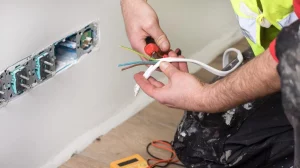Electrical wiring issues can lead to significant expenses if not identified early. Regular inspections of visible wiring for signs of wear, such as fraying or discoloration, are vital. Utilizing tools like a multimeter and receptacle tester can aid in detecting irregularities. In addition, flickering lights and frequent circuit breaker trips may indicate deeper problems. Understanding these signs could save considerable costs. However, knowing when to escalate the situation to a professional is equally important.
Key Takeaways
- Regularly inspect visible wiring for wear and tear, such as fraying or discoloration that may indicate potential issues.
- Utilize a multimeter to check voltage levels and identify any irregularities in your electrical system.
- Monitor circuit breakers for frequent tripping or overheating, which can signal deeper wiring problems.
- Test outlets with a receptacle tester to uncover wiring issues that could lead to costly repairs.
- Schedule regular electrical inspections to detect outdated wiring and prevent future financial burdens from repairs.
Common Signs of Electrical Wiring Problems
How can one identify potential electrical wiring problems before they escalate? Recognizing the common signs of electrical wiring issues is essential for any homeowner. Flickering lights often indicate loose connections or overloaded circuits. Additionally, frequent circuit breaker trips suggest underlying problems that require attention. The presence of a burning smell or scorch marks around outlets points to overheating, which can lead to fire hazards. Moreover, a noticeable increase in electricity bills may signal inefficiencies due to faulty wiring. Homeowners should also be wary of warm or discolored outlets, as this can indicate dangerous conditions. By understanding how to detect electrical wiring issues early, individuals can take proactive measures to safeguard their homes and finances from costly repairs.
Tools You Need to Identify Wiring Issues
A thorough toolkit is crucial for identifying potential electrical wiring issues effectively. Having the right tools not only enhances detection accuracy but also guarantees safety during inspections. Here is a list of essential tools for this purpose:
- Multimeter: Measures voltage, current, and resistance to assess wiring integrity.
- Wire Tester: Checks for live wires, grounding issues, and circuit continuity.
- Voltage Detector: Quickly identifies the presence of voltage without contact.
- Circuit Tracer: Locates specific circuits and identifies breaks in wiring.
- Insulation Resistance Tester: Evaluates insulation quality to prevent shock hazards.
Equipped with these tools, individuals can confidently approach the task of how to detect electrical wiring issues, safeguarding their homes and finances.
Step-by-Step Guide on How to Detect Electrical Wiring Issues
Identifying electrical wiring issues requires a systematic approach to guarantee accurate detection and mitigation. The first step involves inspecting visible wiring for signs of wear, such as fraying or discoloration. Next, utilizing a multimeter can help assess voltage levels and detect any irregularities. Circuit breakers should be examined for tripping or signs of overheating, indicating potential faults. Additionally, testing outlets with a receptacle tester will reveal wiring problems, such as reverse polarity. Homeowners should also be vigilant for unusual odors or buzzing sounds, which may signal electrical issues. Finally, documenting findings can assist in prioritizing necessary repairs. This methodical process is essential for effectively determining how to detect electrical wiring issues before they escalate.

The Importance of Regular Electrical Inspections
Regular electrical inspections play an essential role in maintaining the safety and efficiency of residential and commercial properties. These inspections help identify potential hazards before they escalate into costly repairs or dangerous situations. By proactively addressing issues, property owners can guarantee a safe environment for occupants.
- Detecting outdated wiring that may not meet current codes
- Identifying overloaded circuits that can lead to fire hazards
- Evaluating the condition of electrical panels and breakers
- Uncovering signs of wear and tear in outlets and switches
- Ensuring proper grounding and bonding of electrical systems
When to Call a Professional Electrician
After completing a thorough electrical inspection, property owners may encounter issues that require professional intervention. Signs such as frequent circuit breaker trips, flickering lights, or burning smells indicate the need for immediate expert assistance. Additionally, outdated wiring systems, like knob-and-tube or aluminum wiring, pose safety hazards and should prompt a call to a qualified electrician. If any electrical work involves significant load changes, such as adding new circuits or appliances, professional guidance is essential. Furthermore, property owners should never attempt to address issues that involve high voltage or intricate wiring systems without proper training. Recognizing these scenarios guarantees safety and compliance with electrical codes, ultimately protecting both the property and its inhabitants.
Frequently Asked Questions
How Often Should I Check My Electrical Wiring?
It is recommended to check electrical wiring every three to five years, or sooner if experiencing issues like flickering lights or frequent circuit breaker trips. Regular inspections guarantee safety and functionality, preventing costly repairs or hazards.
Can Electrical Issues Cause Fire Hazards in My Home?
Electrical issues can indeed cause fire hazards in homes. Faulty wiring, overloaded circuits, and damaged insulation can lead to overheating, sparking, or arcing, greatly increasing the risk of residential fires if not addressed promptly and properly.
What Are the Risks of Ignoring Wiring Problems?
Ignoring wiring problems presents severe risks, including electrical fires, appliance damage, and increased energy costs. These hazards compromise safety and financial stability, underscoring the importance of timely detection and resolution of electrical wiring issues.
Are DIY Fixes Effective for Electrical Wiring Issues?
DIY fixes for electrical wiring issues can be effective if performed by knowledgeable individuals. However, improper repairs may lead to safety hazards, requiring professional intervention. Caution and understanding of electrical systems are essential for successful outcomes.
How Do I Choose a Reliable Electrician?
To choose a reliable electrician, verify credentials, read reviews, request references, and compare estimates. Additionally, make certain they possess liability insurance and a warranty for their work, establishing trust and quality assurance in electrical services.
Conclusion
In summary, proactive detection of electrical wiring issues is vital for maintaining safety and preventing financial burdens. By recognizing common signs of wear, utilizing essential tools like multimeters and receptacle testers, and adhering to a systematic inspection approach, individuals can identify potential hazards early. Regular electrical inspections further enhance safety, ensuring that any underlying problems are addressed promptly. Ultimately, prioritizing these practices fosters a secure electrical environment, safeguarding both property and finances from costly repairs.
You May Also Like To Read:


